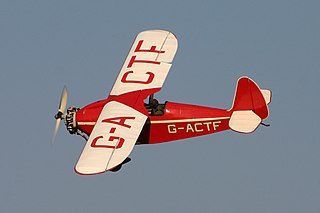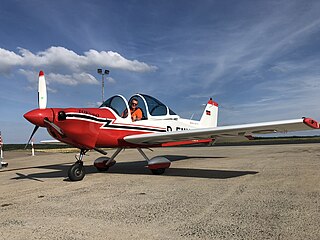
The de Havilland DH.89 Dragon Rapide is a 1930s short-haul biplane airliner developed and produced by British aircraft company de Havilland. Capable of accommodating 6–8 passengers, it proved an economical and durable craft, despite its outdated plywood construction.

The Percival Gull was a British single-engined monoplane, first flown in 1932. It was successful as a fast company transport, racing aircraft and long-range record breaker. It was developed into the Vega Gull and the Proctor.

The de Havilland DH.60 Moth is a 1920s British two-seat touring and training aircraft that was developed into a series of aircraft by the de Havilland Aircraft Company.

The DH.83 Fox Moth is a small biplane passenger aircraft from the 1930s powered by a single de Havilland Gipsy Major I inline inverted engine, manufactured by the de Havilland Aircraft Company.

The General Aircraft GAL.45 Owlet was a 1940s British single-engined trainer aircraft built by General Aircraft Limited at London Air Park, Hanworth.

The Foster Wikner Wicko was a 1930s British two-seat cabin monoplane built by the Foster Wikner Aircraft Company Limited at Southampton Airport, Hampshire.

The Parnall Heck was a 1930s British four-seat cabin monoplane built by Parnall Aircraft Limited at Yate, Gloucestershire. Originally a Hendy design, few were built. It combined the strength and comfort of a cabin aircraft with the speed of a racer.

The Auster J/5 Autocar was a late 1940s British single-engined four-seat high-wing touring monoplane built by Auster Aircraft Limited at Rearsby, Leicestershire.

The Miles M.28 Mercury was a British aircraft designed to meet the need for a training and communications plane during the Second World War. It was a single-engined monoplane of wooden construction with a twin tail and a tailwheel undercarriage with retractable main units.
The Arpin A-1 was a two-seat low-wing monoplane which was powered by a single radial engine in pusher configuration, mounted behind the cabin between twin booms that carried the tail. An unconventional fixed tricycle undercarriage was fitted. Only one was built.

The Comper C.L.A.7 Swift is a British single-seat sporting aircraft designed and produced by the Comper Aircraft Company. It was the company’s first aircraft.

The Caproni Ca.100 was the standard trainer aircraft of the Regia Aeronautica in the 1930s. Large numbers of this tandem, two-seat, biplane were built, powered by different engines.

The Miles Hawk Major was a 1930s British two-seat light monoplane, developed by Miles Aircraft from the Miles Hawk in order to take advantage of the new inverted de Havilland Gipsy Major engine. When fitted with the longer Gipsy Six in place of the forward crew member, it was known as the Miles Hawk Speed Six.

The Heston Type 1 Phoenix was a 1930s British single-engined five-seat light transport monoplane built by the Heston Aircraft Company Limited.

The Elliotts of Newbury EoN or Elliotts EoN A.P.4 was a 1940s British four-seat touring monoplane aircraft built by Elliotts of Newbury.

The Westland Widgeon was a British light aircraft of the 1920s. A single-engined parasol monoplane, the Widgeon was built in small numbers before Westland abandoned production in 1929.

The Comper Mouse was a 1930s British three-seat cabin monoplane designed by Nicholas Comper, and built by the Comper Aircraft Company at Heston Aerodrome in 1933.

The Heston T.1/37 was a 1930s British single-engined monoplane military trainer aircraft with two open cockpits, designed and developed by Heston Aircraft Company Ltd. It was not accepted for service.
The Fane F.1/40 was a 1940s British air observation post aircraft design by Captain Gerald Fane's Fane Aircraft Company.

The Mylius My 102 Tornado is a prototype single-seat German aerobatic aircraft. It was designed as a smaller derivative of the MBB Bo 209, but was not placed in production, with only two aircraft built.





















